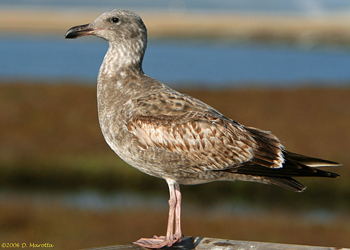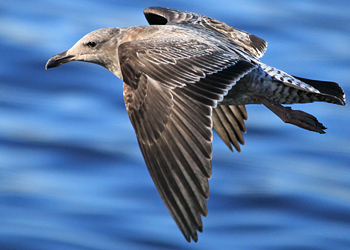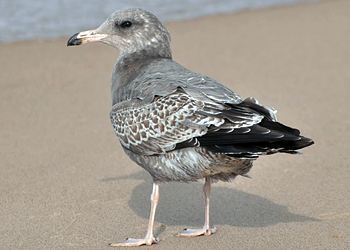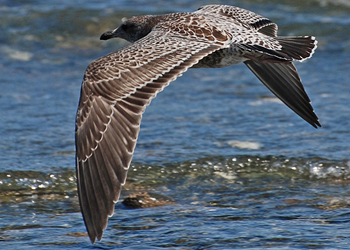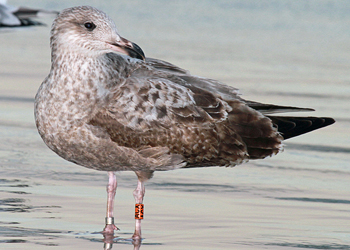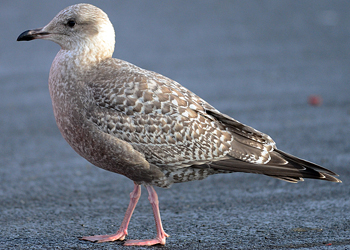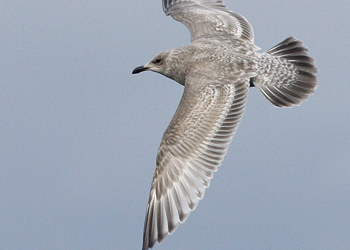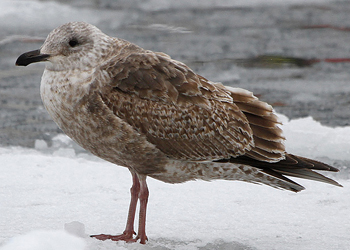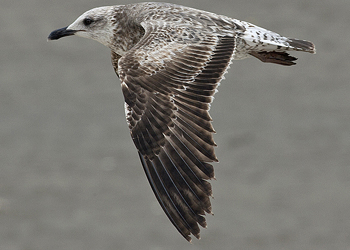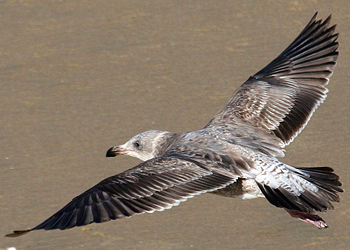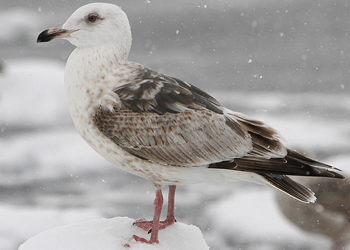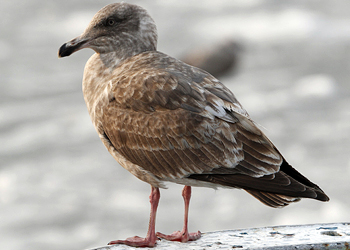|
||
Coordinators: 1cy June 2cy Jan 3cy Jan 4cy / sub-ad Jan adult Jan |
adult: MarchBelow you will find a description of Chapter 31 WESTERN GULL Larus occidentalis, as published in one of the best Gull publication: "Gulls of the Americas" by Steve Howell & Jon Dunn. "we" in the text below refers to the original authors. If any errors occur in this text, please let me know and mail to marsmuusseatgmaildotcom. PART 1 - summary and distribution Field identificationSimilar speciesWestern Gull is the only dark-backed large gull normally found in its range, although first-cycle birds can be confused with other West Coast species. Also see hybrid Glaucous-winged Gull X Western Gull account. Adult Cycle.Several species of dark-backed large gulls can be confused with Western Gull but have limited range overlap (see Rarer Species). Note leg color, darkness of upperparts, wingtip pattern, and overall structure; in winter, adult Western Gull typically has a bright yellow to orange-yellow bill that sets it apart from most other gulls at that season. Adult voice, including long-call, higher pitched than adult Yellow-footed Gull (but can be similar to second-cycle Yellow-footed). Visit Xeno Canto for voices.
Yellow-footed Gull (Gulf of California) has slaty gray upperparts (Kodak 9-10.5) similar to Southern Western Gull but bill thicker and more swollen tipped (often bulging slightly on culmen as well as distinctly at gonydeal expansion), legs yellow, red gonydeal spot typically larger (reflecting deeper bill of Yellow-footed). Wingtips of Yellow-footed more extensively blackish, often with blackish subterminal marks on P4. Prebasic molt averages 1-2 months earlier than Western Gull and white tips to outer primaries usually much reduced by wear in winter (bolder and fresher on Western). Slaty-backed Gull (n. Pacific) has slightly darker upperparts (Kodak 9.5-11.5) than Northern Western Gull, bill less bulbous tipped (and duller yellow in winter, often with flesh pink basally), orbital ring reddish, and head and neck with distinct brownish streaking in basic plumage. Also note Slaty-backed’s broader white trailing edge to secondaries, bolder white tongue-tips and mirrors on outer primaries, and more silvery (less blackish) underside to wingtip (but see hybrid Glaucous-winged Gull X Western Gull). Lesser Black-backed Gull (widespread, but rare in West) more lightly built and slimmer overall with relatively longer and narrower wings (tail tip falls around tip of P6), slender bill. Legs fleshy yellow to yellow. Adult basic has distinct dusky head and neck streaking, and its duller yellow to fleshy yellow bill often has blackish distal marks; orbital ring reddish. First Cycle.Note overall size and structure, bill size and shape, overall dark brown aspect. Also see hybrid Glaucous-winged Gull X Western Gull account. Yellow-footed Gull averages stouter and more swollen-tipped bill, but some are very similar in overall appearance to Southern Western Gull. PA1 molt of Western can include upperwing coverts and tertials on up to 10 percent of wymani (replaced on up to 90 percent of Yellow/footeds); tail coverts have denser dark barring on Western; legs average brighter pinkish on Western; belly more extensively and cleaner white on Yellow-footed. A few birds, however, may defy specific identification. From Oct./Nov. onward, note that first-cycle Yellow-footed Gulls with extensive PA1 molt, including most upperwing coverts and tertials; recall fresh second-basic Western Gull and other species; note pointed juvenal primaries and all-black tail of first-cycle Yellow-footed, plus its deep and swollen-tipped bill. California Gull (w. N. America) averages smaller and more lightly built with relatively longer primary projection, narrower wings, slender bill usually sharply bicolored pink with black tip by early winter. Plumage can be very similar to Western but head and neck usually grizzled with whitish (not solidly dark as typical of Western), forehead and lores often bleach to whitish; A1 scapulars typically more variegated and often with distinct anchor marks (a pattern rare on Western). American Herring Gull (widespread) less thick-set with narrower wings, bill less stout and bulbous tipped, typically dull pinkish at base; A1 scapulars often boldly barred pale gray and blackish. Plumage overall gray-brown, less sooty brown than Western. In flight, note pale inner primary panel on upperwings, often more white at base of tail. First-cycle Herrings often have relatively clean-cut bleached whitish head rarely shown by Western. Thayer’s Gull (mainly w. N. America) smaller with relatively slender bill, upperparts typically with bolder, frostier patterning, brownish black wingtips usually have distinct whitish tips and fringes. Upperwing has contrasting pale panel on inner primaries blending into two-tone outer primaries; tail mostly dark brown. Slaty-backed Gull averages less bulbous-tipped bill, plumage paler overall, bill usually blackish through winter. Upperwings show pale panel on inner primaries blending into two-tone outer primaries, tail has white barring at base. Lesser Black-backed Gull smaller and slimmer with long primary projection, relatively slender black bill; tail base barred white, with contrasting black distal tail band. Second Cycle.Note overall size and structure, bill size and shape, pink legs, incoming slaty gray on upperparts. Also see hybrid Glaucous-winged Gull X Western Gull account. Yellow-footed Gull has stouter and more swollen-tipped bill. Its advanced appearance often recalls third-cycle Western Gull, with more-uniform slaty upperparts than second-cycle Western; legs often yellowish. Distinguished from third-cycle Western by deeper and more swollen-tipped bill, usually fleshy yellow to yellow legs; tail mostly black or mixed black-and-white. California Gull smaller and slimmer with strongly bicolored bill (pink to gray-green basally), incoming medium gray on upperparts, paler gray-green to flesh legs; upperwing has contrasting pale panel on inner primaries. American Herring Gull less thickset with narrower wings, less bulbous-tipped bill; upperparts usually with some to extensive pale gray, and upperwings have more contrasting pale panel on inner primaries. Thayer’s Gull smaller with relatively slender bill, contrasting pale panel on inner primaries blending into two-tone outer primaries, and incoming pale gray on upperparts. Slaty-backed Gull best told by upperwing pattern, with pale inner primary panel blending into two-tone outer primaries, paler secondaries with less-contrasting white trailing edge, and overall plainer and paler coverts, especially greater coverts; in second summer, upperwings of Slaty-backed often more bleached and paler, contrasting more with dark saddle than on Western. Lesser black-backed Gull slimmer end longer winged with relatively slender bill; note white tail base with variable black distal band; legs often yellowish by summer. Third Cycle.Differences much as adult cycle (which see). |
occidentalis Western Gull |
 Western Gull occidentalis ... 4th cycle (5CY), March 04 2010, California, USA. Picture: Alvaro Jaramillo. Western Gull occidentalis ... 4th cycle (5CY), March 04 2010, California, USA. Picture: Alvaro Jaramillo. |
||
 Western Gull occidentalis ... 2406-20723 6th cycle (7CY), March 12 2016, Humboldt County, CA. Picture: Brad Elvert. Western Gull occidentalis ... 2406-20723 6th cycle (7CY), March 12 2016, Humboldt County, CA. Picture: Brad Elvert. |
||
 (pelagic trip, 3-09).jpg) Western Gull occidentalis adult, March 08 2009, off Dana Point, Orange Co. Picture: John Avise. Western Gull occidentalis adult, March 08 2009, off Dana Point, Orange Co. Picture: John Avise. |
||
 Western Gull occidentalis adult, March 21 2009, Crystal Cove, Orange Co. Picture: John Avise. Western Gull occidentalis adult, March 21 2009, Crystal Cove, Orange Co. Picture: John Avise. |
||
 Western Gull occidentalis adult, March 24 2007, Newport, Oregon. Picture: Greg Gillson. Western Gull occidentalis adult, March 24 2007, Newport, Oregon. Picture: Greg Gillson. |
||
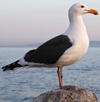 Western Gull occidentalis adult, March 25 2009, Malibu, CA. Picture: Bill'sLIPhotos. Western Gull occidentalis adult, March 25 2009, Malibu, CA. Picture: Bill'sLIPhotos. |
||
 Western Gull occidentalis
Western Gull occidentalis



